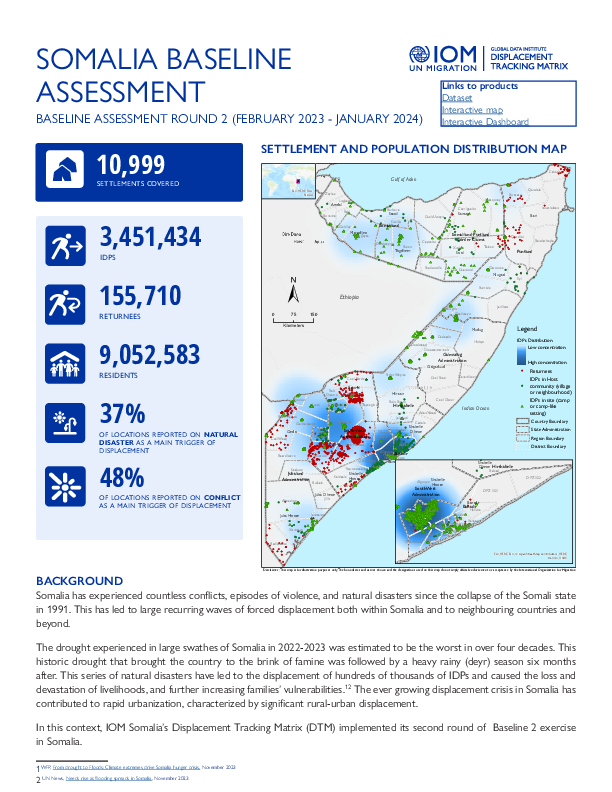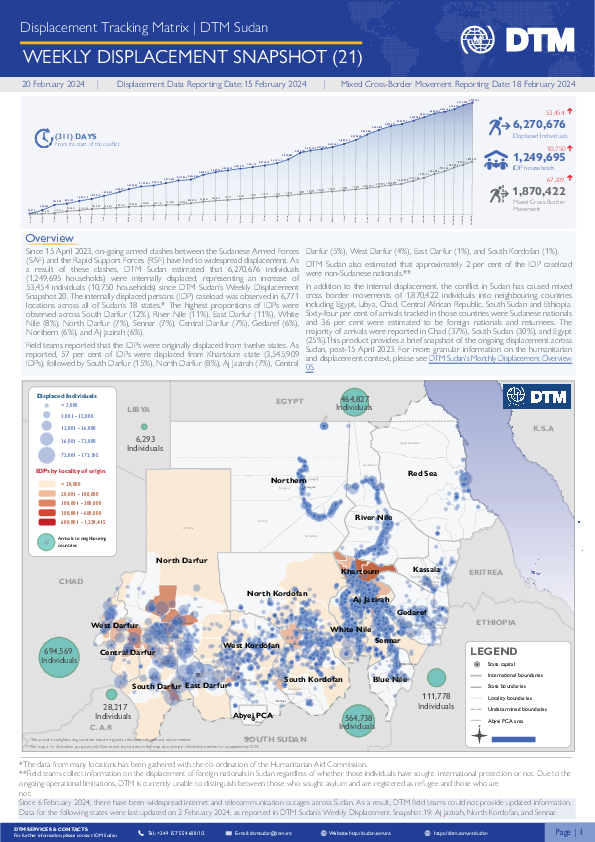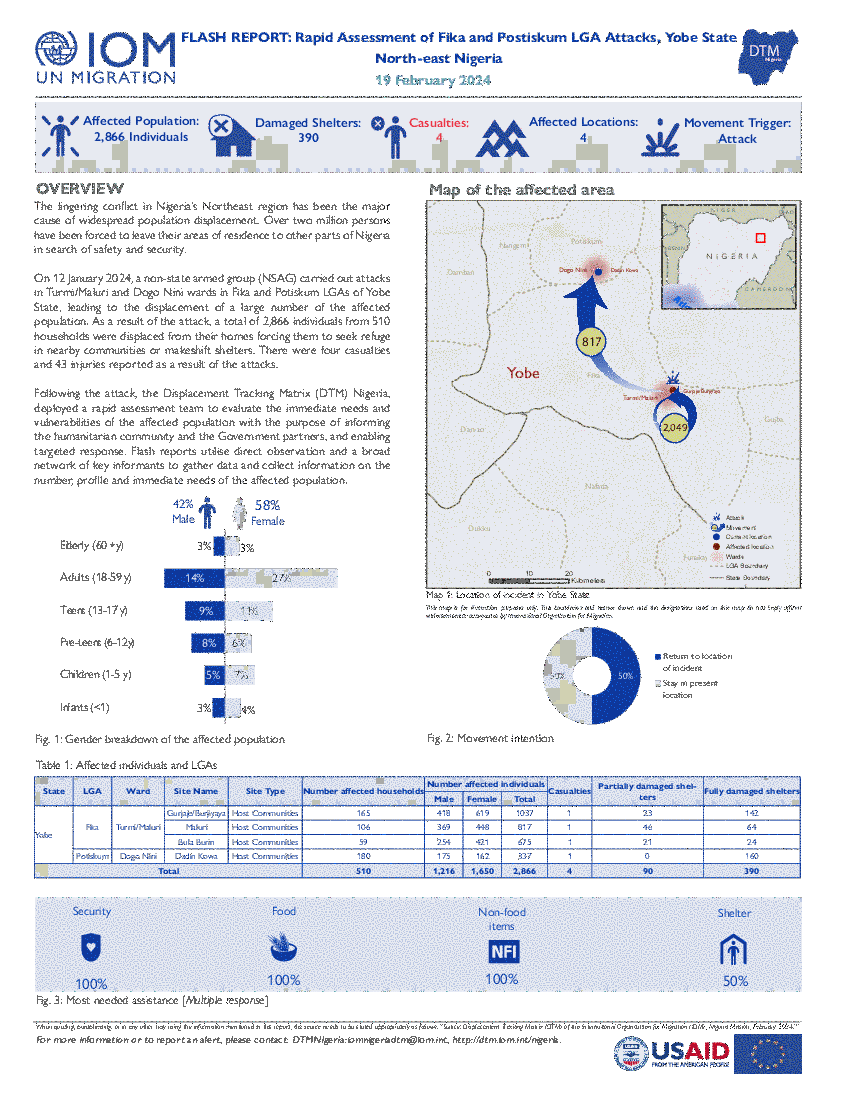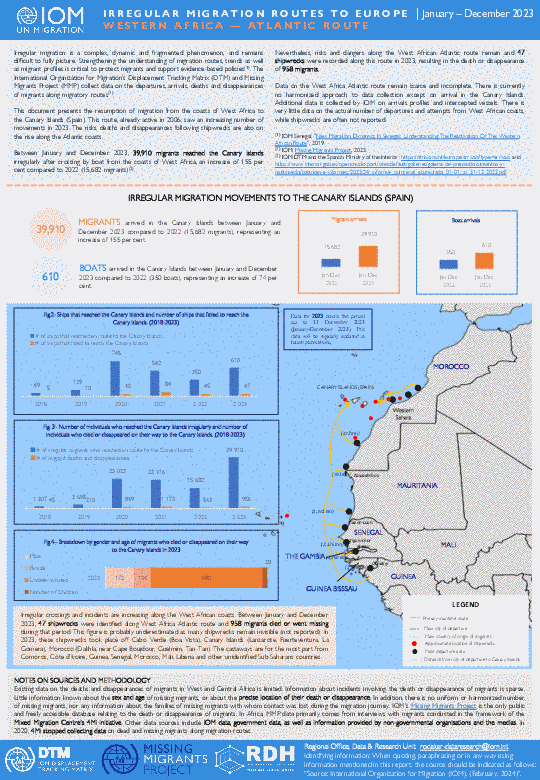-
Countries
-
Data and Analysis
-
Special Focus
-
Crisis Responses

Contact
DTMMozambique@iom.int
Language
English
Location
Mozambique
Period Covered
Feb 08 2024
Feb 20 2024
Activity
- Mobility Tracking
Between 22 December 2023 to 20 February 2024, a series of sporadic attacks and fear of attacks by Non-state Armed Groups in Macomia, Chiure, Mecufi, Mocimboa da Praia, and Muidumbe triggered the cumulative displacement 26,690 individuals/6,760 families. [For more see Emergency Tracking Online Dashboard]. Although included within this cumulative displacement estimate - the current Movement Alert #99 reports on recent attacks recorded in Macomia, Chiure and Mecufi between 8 to 20 February that displaced 13,088 individuals. Montepuez, Mecufi, Erati and Ibo. Movements in the region continue to be dynamic within districts and between Cabo Delgado and Nampula. Within the last 24 hours a significant influx of arrivals from Chiure to Nampula have received across communities in Namapa Sede. Interviews with families are ongoing across registration points in Namapa. Within this reporting period, arrivals of displaced families have been mapped across villages of Ancuabe, Chiure, Erati, Ibo, Macomia, Mecufi, Metuge, Montepuez, Muidumbe, Pemba and Quissanga.

Contact
DTM Burundi, DTMBurundi@iom.int
Language
French
Location
Burundi
Period Covered
Jan 28 2024
Feb 03 2024
Activity
- Mobility Tracking
- Event Tracking
La DTM a identifié 14,941 personnes affectées, dont 2,387 personnes déplacées par les pluies torrentielles, les vents violents et les glissements de terrain les provinces de Bujumbura Rural, Bujumbura Mairie, Bururi, Makamba, Muramvya, Mwaro, Rumonge, Rutana et Ruyigi

Contact
DTM Burundi, DTMBurundi@iom.int
Language
French
Location
Burundi
Period Covered
Feb 11 2024
Feb 18 2024
Activity
- Mobility Tracking
- Event Tracking
La DTM a identifié 5 214 personnes affectées, dont 1758 déplacées par les pluies torrentielles et les vents violents dans les provinces de Bururi, Makamba, Cibitoke et Muyinga.
Irregular migration is a complex, dynamic and fragmented phenomenon, and remains difficult to fully picture. Strengthening the understanding of migration routes, trends as well as migrant profiles is critical to protect migrants and support evidence-based policies. The International Organization for Migration's Displacement Tracking Matrix (DTM) and Missing Migrants Project (MMP) collect data on the departures, arrivals, deaths and disappearances of migrants along migratory routes.
This document presents the resumption of migration from the coasts of West Africa to the Canary Islands (Spain). This route, already active in 2006, saw an increasing number of movements in 2023. The risks, deaths and disappearances following shipwrecks are also on the rise along the Atlantic coasts.
Between January and December 2023, 39,910 migrants reached the Canary Islands irregularly after crossing by boat from the coasts of West Africa, an increase of 155 per cent compared to 2022 (15,682 migrants).
Nevertheless, risks and dangers along the West African Atlantic route remain and 47 shipwrecks were recorded along this route in 2023, resulting in the death or disappearance of 958 migrants.
Data on the West Africa Atlantic route remain scarce and incomplete. There is currently no harmonized approach to data collection except on arrival in the Canary Islands. Additional data is collected by IOM on arrivals profiles and intercepted vessels. There is very little data on the actual number of departures and attempts from West African coasts, while shipwrecks are often not reported.

Contact
DTM Somalia, IOMSomaliaDTM@iom.int
Language
English
Location
Somalia
Period Covered
Feb 01 2023
Jan 31 2024
Activity
- Mobility Tracking
- Baseline Assessment
Baseline 2, an area-based assessment, is the second step of Mobility Tracking implemented at settlement level and aims to quantify presence of population categories.
As of January 2024, DTM Somalia has mapped around 3,451,434 IDPs, 155,710 returnees and 9,052,583 residents across 17 regions and 10,999 assessed locations. IDPs were present in 45 per cent of locations assessed (4,611 locations) and returnees were present in eleven per cent of assessed locations (1,204 locations)
The results include regions of origins, reasons for displacement and accessibility information, as well as the Operational Zones (OPZ) established by OCHA. These zones are designed to support sub-district response and reporting efforts.

Contact
DTM Sudan; dtmsudan@iom.int
Language
English
Location
Sudan
Period Covered
Feb 08 2024
Feb 14 2024
Activity
- Mobility Tracking
- Baseline Assessment
Overview
From 15 April 2023, armed clashes erupted between the Sudanese Armed Forces (SAF) and the Rapid Support Forces (RSF) in multiple cities across Sudan. Clashes initially took place in cities across Northern and Khartoum states, later spreading across the Darfur and Kordofan regions.
Highlights
- DTM Sudan estimates that 6,270,676 Individuals (1,249,695 Households) were recently internally displaced.
- The IDP caseload was observed in 6,771 locations across all of Sudan’s 18 states.
- The highest proportions of IDPs were observed across South Darfur (12%), River Nile (11%), East Darfur (11%), White Nile (8%), North Darfur (7%), Sennar (7%), Central Darfur (7%), Gedaref (6%), Northern (6%), and Aj Jazirah (6%).
- Field teams reported that the IDPs were originally displaced from twelve states. As reported, 57% per cent of IDPs were displaced from Khartoum state (3,545,909 IDPs), followed by South Darfur (15%), North Darfur (8%), Aj Jazirah (7%), Central Darfur (5%), West Darfur (4%), East Darfur (1%), and South Kordofan (1%).
- IOM-DTM also reported that an estimated 1,870,422 mixed cross-border movements were made into neighbouring countries.
- This product provides brief insights into those displaced in Sudan post-15 April 2023. For more granular information on the IDP caseload and the displacement context, please see IOM-DTM's Monthly Displacement Overview (05).
Contact
IOM Somalia DTM iomsomaliadtm@iom.int
Location
Somalia
Activity
- Mobility Tracking
- Baseline Assessment
Period Covered
Feb 01 2023 -Jan 31 2024
Baseline 2, an area-based assessment, is the second step of Mobility Tracking implemented at settlement level and aims to quantify presence of population categories.
As of January 2024, DTM Somalia has mapped around 3,451,434 IDPs, 155,710 returnees and 9,052,583 residents across 17 regions and 10,999 assessed locations. IDPs were present in 45 per cent of locations assessed (4,611 locations) and returnees were present in eleven per cent of assessed locations (1,204 locations)
The results include regions of origins, reasons for displacement and accessibility information, as well as the Operational Zones (OPZ) established by OCHA. These zones are designed to support sub-district response and reporting efforts.
Population Groups
IDPs
Residents
Returnee (Previously Internally Displaced)
Survey Methodology
Unit of Analysis Or Observation
Admin Area 2
Admin Area 3
Admin Area 4
Community
Household
Individual
Site
Site or Location
Type of Survey or Assessment
Key Informant
Keywords
Geographical Scope Full Coverage
Administrative boundaries with available data
The current dataset covers the following administrative boundaries

Contact
NPM Bangladesh, npmbangladesh@iom.int
Language
English
Location
Bangladesh
Snapshot Date
Jan 15 2024
Activity
- Other
The inflow of remittances is one of the main driving forces in Bangladesh’s economic growth and development (IOM, 2021b). Remittances support the economy by increasing foreign exchange reserves and national savings and reducing poverty levels (Chowdhury and Chakraborty, 2021). During the COVID-19 global pandemic in 2020, there was decrease in overseas Bangladeshi migrant workers and the inflow of remittances to the country was initially predicted to decline significantly in 2020 (Asia Development Bank, 2020; World Bank, 2020a). However, contrary to all negative forecasts, recorded remittance inflows to Bangladesh remained resilient during 2020 (IOM, 2021a; IOM, 2022). Nevertheless, even though the emigration of migrants increased again in 2021 and in 2022, the inflow of remittances to Bangladesh started to decline. The World Bank’s prognosis for 2023 expects a further drop in remittances to South Asian countries (World Bank, 2023). This snapshot aims to provide an overview of the remittance situation in Bangladesh between 2019 and 2022.

Contact
DTM Nigeria, iomnigeriadtm@iom.int
Language
English
Location
Nigeria
Snapshot Date
Feb 12 2024
Activity
- Mobility Tracking
- Event Tracking
On 12 January 2024, a non-state armed group (NSAG) carried out attacks in Turmi/Maluri and Dogo Nini wards in Fika and Potiskum LGAs of Yobe State, leading to the displacement of a large number of the affected population. As a result of the attack, a total of 2,866 individuals from 510 households were displaced from their homes forcing them to seek refuge in nearby communities or makeshift shelters. There were four casualties and 43 injuries reported as a result of the attacks.

